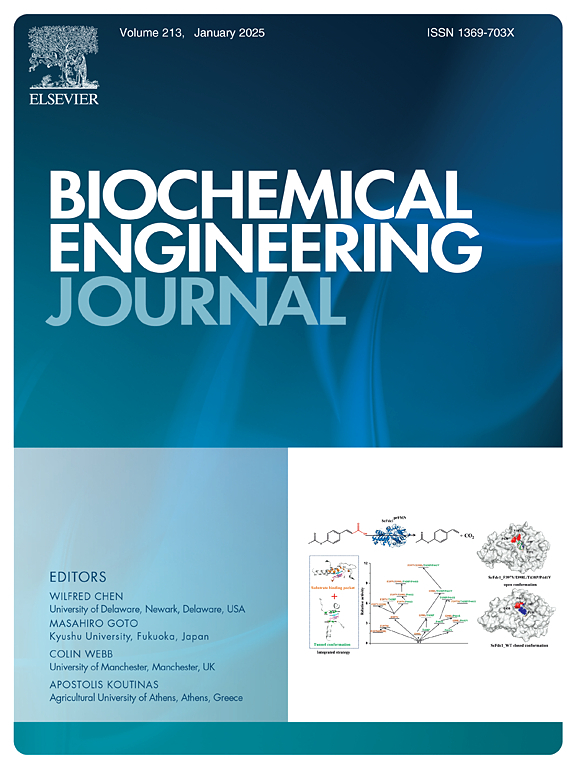利用新型混养小球藻 Cbeo 对养猪场废水进行可持续修复,以生产高价值生物质
IF 3.7
3区 生物学
Q2 BIOTECHNOLOGY & APPLIED MICROBIOLOGY
引用次数: 0
摘要
养猪场废水(PW)中含有高浓度的有机碳(COD)、氮(NH4+-N 和 TN)和磷(TP),这些都是微藻生长所必需的营养物质。本研究试图利用一种新分离的小球藻 Cbeo,通过混养培养将这些化合物回收到其生物量中。研究了影响生物量生产和营养物质去除效率的关键因素,包括氨水平、C/N 比、pH 值、光照强度、灭菌/未灭菌培养基以及室内/室外培养。数据显示,当 NH4+-N 浓度、C/N 比、初始 pH 值和光照强度分别为 250 mg/L、10/1、7 和 150 μmol/m2/s 时,C. sorokiniana Cbeo 在未灭菌培养基中达到最佳生长。在最佳条件下,干细胞重量(DCW)达到最大值 4.30 g/L,略高于灭菌培养基的 4.14 g/L。在 30 L 规模的光生物反应器中,在室内和室外条件下生长的 C. sorokiniana Cbeo 的干细胞重量分别为 3.61 和 3.19 g/L。两种条件下的 COD、NH4+-N、TN、TP 去除率分别为 91.9%-96.7%、96.6%-99.7%、96.2%-96.4% 和 98.2%-100%。C. sorokiniana Cbeo 的生物质含有 14-27 % 的脂质、25-32 % 的碳水化合物、44-48 % 的蛋白质和 0.25-0.97 % 的叶黄素。有趣的是,α-亚麻酸(C18:3n3)占脂肪酸总量的 19.84 -27.0%。C. sorokiniana Cbeo 是开发 PW 可持续生物精炼厂的理想藻种。本文章由计算机程序翻译,如有差异,请以英文原文为准。
Sustainable remediation of piggery wastewater using a novel mixotrophic Chlorella sorokiniana Cbeo for high value biomass production
Piggery wastewater (PW) contains high density of organic carbon (COD), nitrogen (NH4+-N and TN) and phosphorous (TP), which are essential nutrients for microalgae growth. This work was attempted to use a newly isolate Chlorella sorokiniana Cbeo for recovery these compounds into its biomass via mixotrophic cultivation. Critical factors including level of ammonia, C/N ratio, pH, light intensity, sterilized/unsterilized media, and indoor/outdoor cultivations affecting biomass production and nutrients removal efficiencies were investigated. Data revealed that C. sorokiniana Cbeo achieved the optimal growth in the unsterilized medium at NH4+-N concentration, C/N ratio, initial pH, and light intensity of 250 mg/L, 10/1, 7, and 150 μmol/m2/s, respectively. Under the optimal conditions, dry cell weight (DCW) reached the maximal level of 4.30 g/L, which was slightly higher than 4.14 g/L determined for the sterilized medium. In 30 L-scale photobioreactor, C. sorokiniana Cbeo grown under indoor and outdoor achieved DCW of 3.61 and 3.19 g/L, respectively. COD, NH4+-N, TN, TP removal efficiencies for both conditions were determined as 91.9–96.7, 96.6–99.7, 96.2–96.4, and 98.2–100 %, respectively. The C. sorokiniana Cbeo biomass contained 14–27 % lipid, 25–32 % carbohydrate, 44–48 % protein, and 0.25–0.97 % lutein. Interestingly, α-Linolenic acid (C18:3n3) was 19.84 –27.0 % of the total fatty acids. C. sorokiniana Cbeo is the promising algal strain for development of a sustainable biorefinery of PW.
求助全文
通过发布文献求助,成功后即可免费获取论文全文。
去求助
来源期刊

Biochemical Engineering Journal
工程技术-工程:化工
CiteScore
7.10
自引率
5.10%
发文量
380
审稿时长
34 days
期刊介绍:
The Biochemical Engineering Journal aims to promote progress in the crucial chemical engineering aspects of the development of biological processes associated with everything from raw materials preparation to product recovery relevant to industries as diverse as medical/healthcare, industrial biotechnology, and environmental biotechnology.
The Journal welcomes full length original research papers, short communications, and review papers* in the following research fields:
Biocatalysis (enzyme or microbial) and biotransformations, including immobilized biocatalyst preparation and kinetics
Biosensors and Biodevices including biofabrication and novel fuel cell development
Bioseparations including scale-up and protein refolding/renaturation
Environmental Bioengineering including bioconversion, bioremediation, and microbial fuel cells
Bioreactor Systems including characterization, optimization and scale-up
Bioresources and Biorefinery Engineering including biomass conversion, biofuels, bioenergy, and optimization
Industrial Biotechnology including specialty chemicals, platform chemicals and neutraceuticals
Biomaterials and Tissue Engineering including bioartificial organs, cell encapsulation, and controlled release
Cell Culture Engineering (plant, animal or insect cells) including viral vectors, monoclonal antibodies, recombinant proteins, vaccines, and secondary metabolites
Cell Therapies and Stem Cells including pluripotent, mesenchymal and hematopoietic stem cells; immunotherapies; tissue-specific differentiation; and cryopreservation
Metabolic Engineering, Systems and Synthetic Biology including OMICS, bioinformatics, in silico biology, and metabolic flux analysis
Protein Engineering including enzyme engineering and directed evolution.
 求助内容:
求助内容: 应助结果提醒方式:
应助结果提醒方式:


